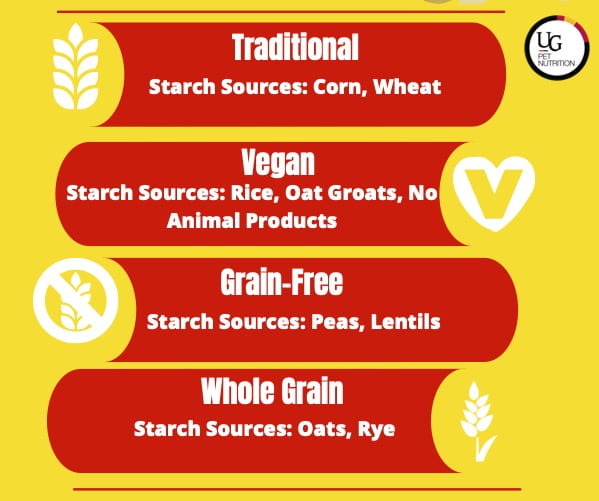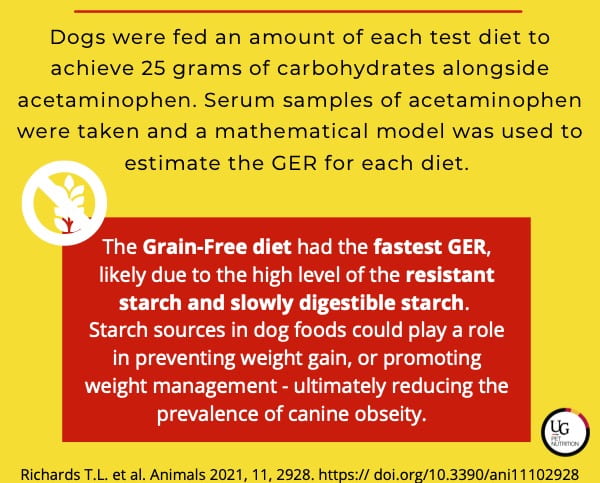Congratulations to our research team for another publication! This time Taylor Richards and colleagues investigated the effects of starch sources on gastric emptying in dogs. The manuscript was published online earlier this week in Animals’ Special Issue The Role of Nutrition in Maintaining Well-being and Health of Dogs and Cats.

When we ingest food, it passes down through the esophagus and enters the stomach. In the stomach, digestive juices and enzymes begin to break down the food into nutrients which get passed through into the small intestine. The passing of nutrients out of the stomach and into the small intestine is referred to as gastric emptying.
The number of nutrients that pass and the speed, or rate, at which they move through the stomach into the small intestine can differ depending on the nutritional make-up of the food that was ingested.
Why is this important? In humans, gastric emptying rates (GER) have been implicated with obesity, diabetes, and other gastrointestinal disorders. While there is extensive research investigating the impacts of dietary protein and fats on GER, there is a lack of research, specifically in dogs, that focuses on the impacts of carbohydrates.
Carbohydrates make up a large component of dog foods. In dry pet foods, carbohydrates can account for 40% to 60% of the dry matter content. Starch is a major component of the carbohydrate content. Starch is made up of amylose and amylopectin and certain starches contain a different ratio of these.

The different proportions of amylose and amylopectin in starch sources can alter the rate of its digestion. Due to this, we can classify starches as rapidly digestible; slowly digestible; and resistant to digestion.
Because of this phenomenon, Richards and colleagues investigated the effects of different starch sources on the GER of dogs.
Eleven Siberian Huskies each received a dose of acetaminophen and one of four diets categorized as: Traditional; Grain-Free; Whole Grain; and Vegan. Blood samples for acetaminophen concentrations were taken at multiple time points after consuming their allocated diet at a portion providing 25 grams of carbohydrates.
Using the acetaminophen concentrations and a mathematical model, the researchers were able to estimate the rate of gastric emptying.

The results of this study show that when fed the diet with the largest amount of resistant starch, dogs had more gastric emptying at a faster rate. The diet with the most resistant starch was the grain-free diet. The starch sources in the grain-free diet were peas and lentils.
This research shows that different starch sources can have an impact on digestion and nutrient absorption in dogs. More research is needed to determine how this could affect gastrointestinal health and function, as well as the dog’s body condition i.e. weight gain and weight loss.
This research was sponsored by NSERC Collaborative Research Development Grant in partnership with PPN Limited Partnership (Petcurean).
Post Written and Infographic Created by: Hannah Godfrey (BSc.H. | MSc. | Ph.D. Student)
Edited by: Dr. Adronie Verbrugghe (DVM | PhD |EBVS Specialist in Veterinary and Comparative Nutrition® (Dip ECVCN)) and Alex Rankovic (BSc.H. | MSc. | Ph.D. Candidate)
Richards, T.L.; Rankovic, A.; Cant, J.P.; Shoveller, A.K.; Adolphe, J.L.; Ramdath, D.; Verbrugghe, A. Effect of Total Starch and Resistant Starch in Commercial Extruded Dog Foods on Gastric Emptying in Siberian Huskies. Animals 2021, 11, 2928. https://doi.org/10.3390/ani11102928


